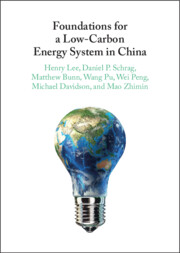Book contents
- Foundations for a Low-Carbon Energy System in China
- Foundations for a Low-Carbon Energy System in China
- Copyright page
- Contents
- Acknowledgments
- 1 Introduction
- 2 Reforming China’s Electricity Market to Facilitate Low-Carbon Transition
- 3 Promoting Large-Scale Deployment and Integration of Renewable Electricity
- 4 Enabling a Significant Nuclear Role in China’s Decarbonization
- 5 Transitioning to Electric Vehicles
- 6 From Barrier to Bridge
- 7 Coordinating Strategies to Reduce Air Pollution and Carbon Emissions in China
- 8 Conclusion
- Index
- References
4 - Enabling a Significant Nuclear Role in China’s Decarbonization
Loosening Constraints, Mitigating Risks
Published online by Cambridge University Press: 02 December 2021
- Foundations for a Low-Carbon Energy System in China
- Foundations for a Low-Carbon Energy System in China
- Copyright page
- Contents
- Acknowledgments
- 1 Introduction
- 2 Reforming China’s Electricity Market to Facilitate Low-Carbon Transition
- 3 Promoting Large-Scale Deployment and Integration of Renewable Electricity
- 4 Enabling a Significant Nuclear Role in China’s Decarbonization
- 5 Transitioning to Electric Vehicles
- 6 From Barrier to Bridge
- 7 Coordinating Strategies to Reduce Air Pollution and Carbon Emissions in China
- 8 Conclusion
- Index
- References
Summary
While China is building nuclear reactors faster than any other country in the world, major constraints may limit nuclear energy’s ability to grow to the scale of hundreds of gigawatts that would be required for it to play a major part in decarbonizing China’s energy system. This chapter explores the major constraints on, and risks of, large-scale nuclear energy growth in China, and how both new policies and new technologies might address them. It focuses particularly on the two biggest constraints – economics and siting. Substantial government policies to support nuclear power and advanced reactor systems designed to address some of the key constraints are both likely to be needed for nuclear to have a chance of playing a major role in decarbonizing China’s energy system; nuclear energy’s role may be bigger in the second half of this century than in the first half.
Information
- Type
- Chapter
- Information
- Foundations for a Low-Carbon Energy System in China , pp. 65 - 100Publisher: Cambridge University PressPrint publication year: 2021
